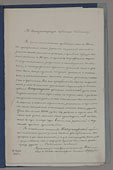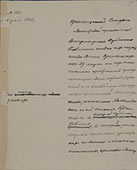Archival Documents
The Department of Archival Documents of the National Library keep the Records of the Imperial Public Library «On the acquisition of the Bishop Porphyrius collection of manuscripts in the Greek, Slavic, Arabic, Georgian and other Oriental languages" (RNB. OAD. Fund 1. IPB. Inventory 1. 1883. No.4. 37 fols. Documents reveal the curious circumstances of the purchase of the collection by the library.
A letter from Bishop Porphyrius to the Imperial Public Library, making an offer to buy his collection (RNB. OAD. Fund 1. IPB. Inventory 1. 1883. No. 4. Fol. 1) was sent from the New Monastery of the Saviour, headed by the bishop, and is dated to 29 March 1883. This letter contains not only a description of the collection, but also the reasons that drove the owner to sell the manuscripts to the Imperial Public Library: Bishop Porphyrius writes, 'in order that they would not dispersed here and there after my death, and so that I could print my works with many, many pictures, illustrations and drawings'. The owner asked 15,000 rubles for his collection, granting the possibility of installment payments for three or four years.Director of the Imperial Public Library A. Bychkov very quickly take the necessary steps to raise money. Already on 2 April 1883, he addressed to Minister of Finance Privy Councilor N. Bunge and asked him to intercede with the Emperor for a grant of 15,000 rubles from the State Treasury to the Public Library for purchase of the collection of Bishop Porphyrius. The letter contains a description of the collection with the mention of the most valuable manuscripts:
«…in writing, Bishop Porphyrius suggested to the Library to buy his collection of manuscripts in the Greek, Slavic, Arabic, Georgian and other Oriental languages for 15,000 rubles in installment payments for three or four years. The collection of the Reverend Porphyrius, amassed, actually, as he writes, for our Fatherland, during his 18-year period of stay in different lands of the Christian East, has long been known to both domestic and foreign scholars. Many of his manuscripts were used by Tischendorf - for his publication of the New Testament, by Sreznevsky - for his «Collection of the little-known and unknown landmarks in the Church Slavonic language», by Pavlov - for the study of Nomocanon, by Baron Rosen - for the publication of Annals of Yahya of Antioch, and by others. The collection consists of 125 manuscripts in different languages, 20 Arab printed books and 590 fragments from manuscripts of the most diverse contents partly in originals, partly in copies, valuable in respect of paleography and especially for students of medieval art of the Christian East. Among the Greek manuscripts, most of which contain the dates of their writing, are particularly worthy of notice: the Four Gospels of 895; the Psalter of 862, written in the year of the foundation of the Russian state; the Apostle transcribed in 1301 from the copy of 399; the annual set of the 12th century Menaion (the liturgical book consisting of twelve volumes, one for each month); the Euchologion or the Book of Needs of the 8th century — one of the most precious manuscripts of its kind, containing, by the way, a lot of unknown prayers and the Divine Liturgy of St. John Chrysostom with some specific features in the arrangement, the works of the Church Fathers: Ephraim the Syrian, John Chrysostom, Bishop Theophylact of Bulgaria and others in the tenth and eleventh century copies; the collection of the 13th century, which contains the eleventh and twelfth century correspondence of various royal persons, nobles and clerics; as well as different poems. Among the Slavic manuscripts are notable: the Book of the Gospel Readings of 1195 — a very important manuscript in the Church Slavonic language; the thirteenth century Life of St. Pancras of Taormina; the thirteenth - fourteenth century Nomocanon written on bombazine; several chronicles and chronographs. Among the manuscripts in Oriental languages are particularly important: the Georgian one on papyrus - due to its antiquity; the Arabic one - the Gospel of 1136; the Annals of Patriarch Eutychius of Alexandria; the Chronicle of John of Antioch… I do not mention the fragments of manuscripts, the oldest of which dates to 715, especially because some of them has been already published. Relying on this brief list of Reverend Porphyrius' collection which I personally know, you can consider how it is important scientifically and whether it would be desirable to include it in the holdings of Iperial Public Library…» (RNB. OAD. Fund 1. IPB. Inventory 1. 1883. No. 4. Fols. 2-3v.).
A letter of reply from A. Bychkov to Bishop Porphyrius is dated to the next day - 3 April 1883. The rough copy of the letter (without the final formula of etiquette and his signature) is preserved in a file (RNB. OAD. Fund 1. IPB. Inventory 1. 1883. No. 4. Fols. 5-6v.). Especially noteworthy are the following words of A. Bychkov,'The Public Library will preserve your collection in its entirety for distant posterity, and, using it, scientists will recall, with respect and appreciation, your name closely connected with the discovery of the famous Sinai Bible which is also stored in the library and is one of its jems.'
An archive file contains 31 documents, the last one is dated to 27 August 27 1887, when Bishop Porphyrius was no longer alive. The content of the documents shows that the required 15,000 rubles for the purchase of the collection were found and included in the budget estimates of the Ministry of Public Education: 5000 rubles in 1883, and in further four years - 4000 rubles in 1884, and 2000 rubles annually in 1885, 1886 and in 1887. The State Council upheld the decision of the Minister of Finance to allocate money on 3 January 1884. 'His Majesty Emperor [Alexander III] deigned to approve the expressed opinion of the State Council… and ordered to fulfil' (RNB. OAD. Fund 1. IPB. Inventory 1. 1883. No. 4. Fols. 21–21v.). In July 1883, Bishop Porphyrius received the first payment in the amount of 5,000 rubles, as he notified the Library (RNB. OAD. Fund 1. IPB. Inventory 1. 1883. No. 4. Fol. 16).
The following year, Bishop Porphyrius addressed to the Library with a request to pay him the remaining amount for not four, but for three years,
'The sooner I get the requested sum, the sooner I can prepare numerous photolithographic drawings to my writings on eastern and western church painting, including mosaic, iconic on boards, mural and book one' (RNB. OAD. Fund 1. IPB. Inventory 1. 1883. No. 4. Fol. 22); 'More distant deadline for payment of this remaining sum to me will delay my illustrated publications on church and book painting, which are now being prepared by two artists, one of whom makes drawing copies and the second makes photolithographs of ancient icons of Greek, Georgian, Bulgarian, Serbian, Abyssinian, and other origin. A slowdown in this business in my advanced years (my 80th year), a delay even for one year forces me to think and ask what I ask' (RNB. OAD. Fund 1. IPB. Inventory 1. 1883. No. 4. Fol. 26v.).
But the established order was not possible to change: until his death, Bishop Porphyrius had time to recieve, in addition to the first 5,000 rubles, only two payments: 4000 rubles in 1884 and 2000 rubles in 1885. (RNB. OAD. Fund 1. IPB. Inventory 1. 1883. No. 4. Fols. 25, 31).
After the death of Bishop Porphyrius that occurred on 19 April 1885, the Library transferred the remaining 4,000 rubles to the Imperial Academy of Sciences to which Bp. Porphyrius bequeathed his property and capital (24,000 rubles) for gradual printing his works. (RNB. OAD. Fund 1. IPB. Inventory 1. 1883. No. 4. Fols. 32–37).


